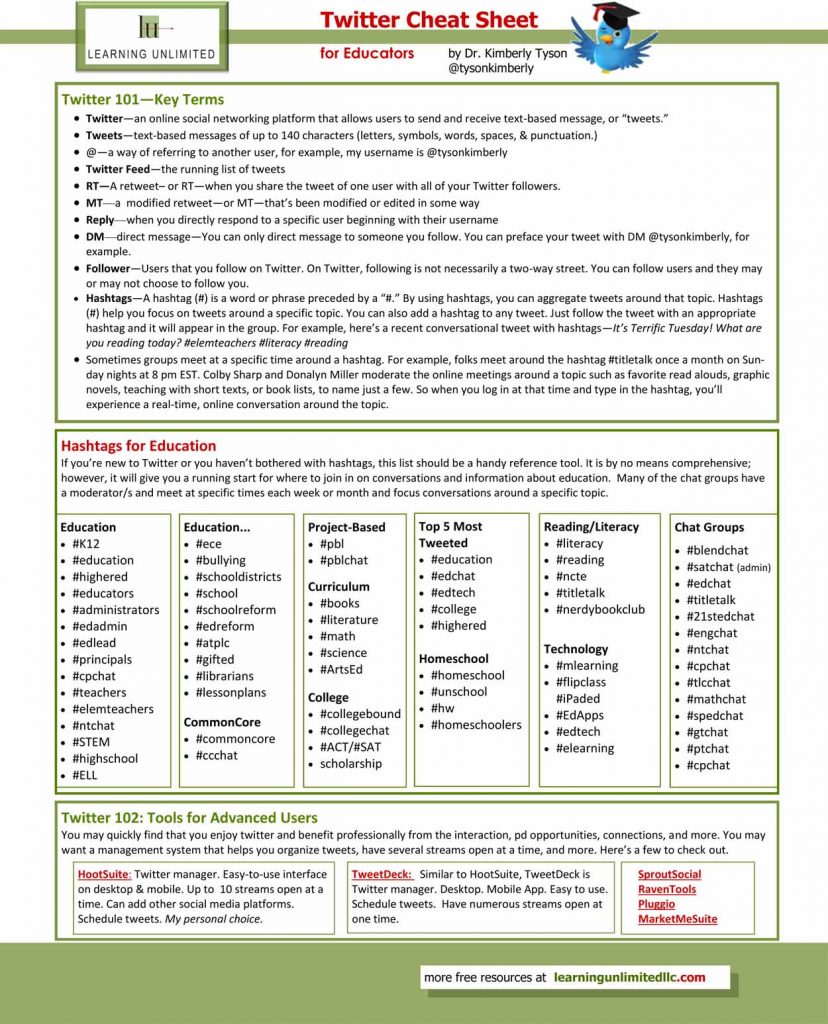By Kimberly Tyson of learningunlimitedllc.com
We’ve sung the praises of twitter in the classroom in the past–far and away our favorite social media tool of 2012. But while simple to use simply, it’s not the easiest tool to master.
Thus this chart.
Twitter for Educators
Twitter, the popular social media platform, is continually picking up momentum in its number of users; however, I find many educators who are not tapping into the power of Twitter. The mystery that surrounds Twitter, I believe, keeps many people from benefiting from the potential it holds. Consider this recent post on Facebook from a friend who revealed, “My mom thought that hashtags were code messages.” While the post made me chuckle, to those who don’t use Twitter, terms like tweets, retweets, and hashtags, can seem pretty foreign and intimidating.
For those just getting started, I’ll explain a few basic terms to help you easily and quickly navigate your way around Twitter. For those who already use Twitter, you may want to jump down to the next section, Benefits for Educators, or simply download the Twitter Cheat Sheet.
Twitter: The Basics
- Twitter: According to Wikipedia, Twitter is an online social networking and microblogging service that enables its users to send and read text-based messages, called “tweets.” A helpful way to think of Twitter is to picture a constantly flowing stream of water. Tweets are the stream. As a user, you dip your toes in and out of the ongoing stream of tweets. You can’t expect to take it all in, simply read a few tweets and then step out.
- Tweet: “Tweets” are text-based messages of up to 140 characters (letters, symbols, words, spaces, & punctuation).
- Choosing a Name: To begin, simply sign up for a free account. Try to select a username that is your name or close to it so that people can easily find you by searching. For example, Kimberly Tyson (my name) was taken, @tysonkimberly was available so that became my username. People can still find me easily by searching for my name.
- Following: You’ll want to connect to other educators by following them which can be done in two ways. First, click the Follow button when you see it next to a user’s profile photo or you can click the Follow button next to any of your followers. Start by searching for people you know or educators that you have read or heard at conferences – just type in their name to see if they’re on Twitter. On my literacy blog, I recently featured a list of educators who blog about books, reviews, and more. You can view those here.
- Hashtags (#): A hashtag (#) is a word or phrase preceded by a “#.” By using hashtags, you can aggregate tweets around that topic. Hashtags help you focus on tweets around a specific topic. You can also add a hashtag to any tweet. Just follow the tweet with an appropriate hashtag and it will appear in the group. For example, here’s a recent tweet with 2 hashtags—Vocab instruction stale? Perk it up! Attend Top 10 Vocab Strategies – free Webinar Dec 12 4-5pm bit.ly/Vd9nGG #principals #elemteachers By the way, best practice is to limit the number of hashtags following a tweet. Only use the hashtag if that group would be interested in or benefit from your post.
- Chat groups: Chat groups are frequently formed around a specific topic of interest and they meet regularly through Twitter. The group is defined by a specific hashtag. To join the group, you simply type in the hashtag and you can follow the posts and contribute to the conversation by posting a tweet followed by the hashtag. Two examples, #TitleTalk and #Satchat, are summarized below.
- #TitleTalk, a group who shares about how to best promote reading and specific books to students, meets once a month on Sunday nights. Colby Sharp (@colbysharp) and Donalyn Miller (@donalynbooks) moderate the online meetings around a topic such as favorite read alouds, graphic novels, teaching with short texts, or book lists, to name just a few. So when you log in at that time and type in the hashtag, you’ll experience an online conversation around the topic.
- #Satchat, another active group, is a weekly Twitter chat for current and emerging school leaders who meet around all things education. Brad Currie (@bcurrie5) and Scott Rocco (@scottrocco), two administrators, are the co-founders and moderators of the lively discussions held each Saturday morning at 7:30am EST. Grab your coffee and join them!
Want to get started? You’ll find more groups specific to educational technology, literacy, content areas, school reform, and more. I’ve compiled a list of many chat groups on the Twitter Cheat Sheet which is downloadable from this post.
Benefits for Educators
- Connections: Twitter, at its heart, is a place to build connections with other educators – those next door and those across the country and world. Twitter can help you stay connected and up-to-date with news and resources shared by other school leaders.
- Collaborations: Start your own hashtag to collaborate with colleagues. Additionally, have students create their own hashtag for a group research project. Then group members can save their links to resources and share information through the common stream designated by their hashtag. They’ll be able to easily see others results and research by simply searching by their hashtag.
- Resources: Another benefit of Twitter is sharing and receiving resources. Take time to share your favorite resources by providing links to them and be prepared to receive a steady stream of resources from others. For example, I posted a link on Twitter to the Common Core Toolkit that I recently created. From that link and others on various social media platforms, it’s been downloaded 500 times in just 4 weeks. Do you need advice about a resource or technology tool that you’re getting ready to purchase? Just ask on Twitter and you’ll probably receive lots of feedback which can ultimately help you research and make decisions.
- Professional development: Professional development opportunities are yet another great reason to be active on Twitter. In a time when many schools have limited funds to support professional development, Twitter can serve as a great resource to learn about free webinars, cost-effective professional learning opportunities, and more. For example, I provided four free literacy webinars this fall (the final vocabulary webinar is this Wednesday) and many educators registered through a link posted on Twitter. Finally, share in the conversation by tweeting about your educational activities, favorite conference, read aloud, tech tool, and more.
A Word to the Wise
It is important to remember that, although there are privacy settings, you need to be careful what you tweet. As a general rule, anyone can read your tweets – parents, students, fellow educators, your kids, spouse, partner, and even your favorite grandma. Keep it respectful.
Twitter, like any other social media tool, can suck you in and absorb a lot of time. Keep in mind…steady stream…dip in and dip out. You can’t catch all the drips nor should you try to.
Final Thoughts
Twitter, as a social media tool, is powerful for educators far beyond the obvious benefit of connecting with educators worldwide. Follow people you know, follow educators you don’t know, and build a community. You’ll soon get the hang of dipping your toe in and out of the stream of tweets and benefit professionally from the experience.
Cheat Sheet: Twitter For Teachers

